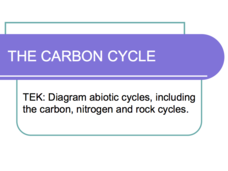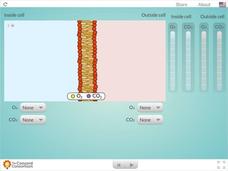Oxygen Teacher Resources
Find Oxygen lesson plans and worksheets
Showing 2,464 resources
Steve Spangler Science
Egg in a Bottle...The Tricky Way - Cool Science Experiment
A teenaged Jack Spangler demonstrates how reducing air pressure in a bottle can pull a boiled egg inside. Then dad does a similar demonstration using liquid nitrogen to reduce the air pressure. Even though the result is the same, the...
Curated OER
Fuel Cell Experimentation
With rising oil prices and increasing concerns over global warming, the pressure is on for engineers to develop alternative sources of energy. Among the new technologies being developed are hydrogen fuel cells, which young scientists...
American Chemical Society
Air, It's Really There
Love is in the air? Wrong — nitrogen, oxygen, and carbon dioxide are in the air. The final lesson in the series of five covers the impact of temperature on gases. Scholars view a demonstration of gas as a type of matter before performing...
Berkeley University of California
Chemical Reactions
Learn about how chemical reactions require energy to activate and how to draw energy diagrams for chemical reactions. After watching the video, learners discuss why mixing hydrogen and oxygen gas in a balloon won't result in water.
Berkeley University of California
Catalysis
Jump-start your understanding of catalysis in chemical reactions. An educational video explains the basic concept of catalysis and its relation to energy. It also introduces platinum plates as a catalyst for the reaction between...
Berkeley University of California
Examples of Isotopes
I so hope you'll learn about isotopes. Watch a video to understand that isotopes of an element have the same number of protons but different numbers of neutrons. Then solidify the knowledge by examining examples of hydrogen,...
TED-Ed
How a Single-Celled Organism Almost Wiped out Life on Earth
Meet cyanobacteria, the single-celled organism that changed the world by causing the first mass extinction of life forms, gave rise to oxygen breathing life forms, and was responsible for the first Ice Age.
Virginia Department of Education
Partial Pressure
At some point, everyone has been under pressure—even Dalton! Explore Dalton's law of partial pressures with young chemists as they measure the volume of air extracted from a sample compared to its original volume. Class...
Crash Course
Photosynthesis
Seventy percent of the world's oxygen is produced through photosynthesis by phytoplankton, microscopic plants found in the ocean. Viewers learn about the complex process of photosynthesis with a video that covers both the light...
Wylie Independent School District
The Carbon Cycle
Carbon is the fourth most abundant element in the universe (in terms of mass), behind hydrogen, helium, and oxygen. Scholars learn about the carbon cycle, from ways carbon is removed from the atmosphere to how it is added in...
Columbus City Schools
Photosynthesis and Respiration
Thirty percent of the world's oxygen is produced by rainforests found throughout the world. Seventh grade learners explore the processes of photosynthesis and respiration through 10 days of labs, manipulatives, and discussions. They...
American Chemical Society
Molecules in Motion
I heard that oxygen and magnesium were going out and I was like "O Mg." Pupils experiment with adding food coloring to water of various temperatures in order to determine how temperature impacts molecular movement. This is the...
Krista King Math
Ratio and Proportion for Chemical Compounds
Explore the strong connection between mathematics and science. Learners see how to use proportions to determine the makeup of chemical compounds. The example shown finds the number of grams of oxygen in a given amount of water.
SciShow
Tiny Extremophiles Living in Rocks!
From the hottest places on Earth to the coldest, from inside rocks to underground with no oxygen, this video details the extreme conditions under which living things are still able to survive.
Fuse School
Calculating Percentage Mass
More than half of your body is made of water, but what percentage of you is made up of hydrogen? This video explains how to solve for percentage mass. It uses water as one example of solving for both hydrogen and oxygen.
Crash Course
Blood – There Will Be Blood (Part 2)
Since 2004, blood doping in cycling has dropped by 50 percent. The video opens with a narration about blood doping and then focuses on the structure of blood and how its parts work to keep the body alive. Classes learn about the...
Veritasium
Where Did The Earth Come From?
What are we made of and where did all of this stuff come from? From the Big Bang to star dust, the narrator of an entertaining video explores many different theories. Scholars learn the sequence of events that had to occur to create the...
Concord Consortium
Diffusion Across a Permeable Membrane
Oxygen and carbon dioxide freely cross cell membranes. The simulation demonstrates the diffusion of these across a permeable membrane. To create a great visual for users, it graphs the balance of molecules as it changes throughout the...
American Chemical Society
The Science of Distance Running
Don't run from an informative resource. Individuals view a video in the ACS Reactions series that discusses the science of distance running. It explains how energy, oxygen, and water are necessary for running and describes the mechanics...
American Chemical Society
How Do Sparklers Work?
Fire up some interest in sparklers. Pupils learn how the combustion of metals with oxygen forms the basis of sparklers. The informative video in the ACS Reactions series explains how the ingredients mix together to form a combustible paste.
American Chemical Society
Why Is the Statue of Liberty Green?
See how Lady Liberty turned green. Young scientists learn that oxidation reactions have caused the originally red-brown Statue of Liberty to become its current shade of green. An engaging video explains how the copper in the statue...
JFR Science
Percent Composition
Everyone knows water is made of hydrogen and oxygen ... but how much of each? Science scholars explore percent composition through a video from JFR Science. The narrator provides background information, time-saving tips, and example...
PBS
Sherpas on Everest
Every successful climb of Mount Everest can be attributed to the assistance of the local Sherpas. A short, informative article explains the history behind the Sherpa's involvement in Mount Everest expeditions, the physiological reasons...
Cambridge University
How Sherpas Have Evolved "Superhuman" Energy Efficiency
Why are Sherpas so uniquely equipped to guide aspiring mountain climbers up Mount Everest? Learn all about the biological ways that Sherpas can survive in a low-oxygen environment with an informative video.
Other popular searches
- Carbon Dioxide Oxygen Cycle
- Dissolved Oxygen
- Oxygen and the Human Body
- Oxygen Cycle
- Oxygen and Carbon Dioxide
- Carbon Oxygen Cycle
- Oxygen Carbon Dioxide
- Oxygen Cycle Diagram
- Solubility Oxygen
- Mount Everest Without Oxygen
- Plants and Oxygen
- Transporting Oxygen, Glucose

























